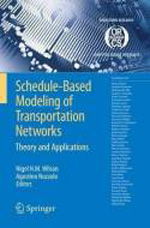Scheduled-based dynamic transit modeling
theory and applications
- ISBN: 9781402076879
- Editorial: KLUWER ACADEMIC PUBLISHERS
- Fecha de la edición: 2004
- Lugar de la edición: Dordrecht. Países Bajos
- Colección: Operations research/computer science interfaces
- Encuadernación: Cartoné
- Medidas: 24 cm
- Nº Pág.: 282
- Idiomas: Inglés

Schedule-Based Dynamic Transit Modeling: Theory and Applications outlines the new schedule-based dynamic approach to mass transit modeling. In the last ten years the schedule-based dynamic approach has been developed and applied especially for operational planning. It allows time evolution of on- board loads and travel times for each run of each line to be obtained, and uses behavioral hypotheses strictly related to transit systems and user characteristics. It allows us to open new frontiers in transit modelling to support network design, timetable setting, investigation of congestion effects, as well as the assessment of new technologies introduction, such as information to users (ITS technologies). The contributors and editors of the book are leading researchers in the field of transportation, and in this volume they build a solid foundation for developing still more sophisticated models. These future models of mass transit systems will continue to add higher levels of accuracy and sensitivity desired in forecasting the performance of public transport systems. INDICE Preface. General Aspects. 1: The Schedule-Based approach in dynamic transit modelling: a general overview; A. Nuzzolo, U. Crisalli. 1.1. Introduction. 1.2. User target time and demand temporal segmentation. 1.3. Transit supply models. 1.4. Schedule-based path choice models. 1.5. Schedule-based assignment models. 1.6. Conclusions. 2: A dynamic mode transit service choice model to design ex-urban transport service timetables; E. Cascetta, A. Papola. 2.1. Introduction. 2.2. The proposed joint mode-transit service choice model: general structure. 2.3. The database and choice set definition. 2.4. Estimation of the model. 2.5. Conclusion. 3: Finding shortest time-dependent paths in Schedule-Based transit networks: a Label Setting algorithm; M. Florian. 3.1. Introduction. 3.2. General problem definition. 3.3. The deterministic transit assignment algorithm. 3.4. Application issue. 3.5. Conclusions. 4: A large
eds.Nigel H.M.Wilson;Agostino Nuzzolo







